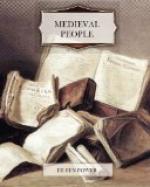That Thomas Paycocke had many friends, not only in Coggeshall but in the villages round, the number of his legacies bears witness. His will also shows that he was a man of deep religious feeling. He was a brother of the Crutched Friars of Colchester and left them on his death five pounds to pray ‘for me and for them that I am bound to pray fore’. It was customary in the Middle Ages for monastic houses to give the privilege of the fraternity of the house to benefactors and persons of distinction; the reception took place at a long and elaborate ceremony, during which the consrater received the kiss of peace from all the brethren. It is a mark of the respect in which Thomas Paycocke was held in the countryside that he should have been made a brother by the Crutched Friars. He seems to have had a special kindness for the Order of Friars; he left the Grey Friars of Colchester and the Friars of Maldon, Chelmsford, and Sudbury each ten shillings for a trental and 3s. 4d. to repair their houses; and to the Friars of Clare he left twenty shillings for two trentals, ’and at Lent after my deceste a kade of Red heryng’. He had great interest in Coggeshall Abbey; it lay less than a mile from his house, and he must often have dined in state with the abbot at his guest table on feast days and attended Mass in the abbey church. He remembered the abbey as he lay dying, and the sound of its bells ringing for vespers came softly in at his window on the mellow September air; and he left ‘my Lord Abbot and Convent’ one of his famous broadcloths and four pounds in money ’for to have a dirige and Masse and their belles Ryngyng at my buriall when it is doon at Chirche, lykewyse the vijth day and mounth day, with iij tryntalls upon the same day yf they can serve them, orells when they can at more leasur, Summa x li.’
His piety is shown also in his bequests to the churches of Bradwell, Pattiswick, and Markshall, parishes adjacent to Coggeshall, and to Stoke Nayland, Clare, Poslingford, Ovington, and Beauchamp St Pauls, over the Essex order, in the district from which the Paycockes originally came. But his greatest care was naturally for Coggeshall Church. One of the Paycockes had probably built the north aisle, where the altar was dedicated to St Katherine, and all the Paycocke tombs lay there. Thomas Paycocke left instructions in his will that he should be buried before St Katherine’s altar,




